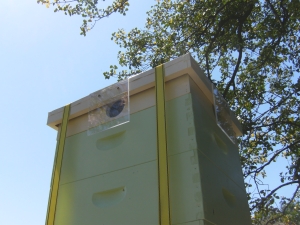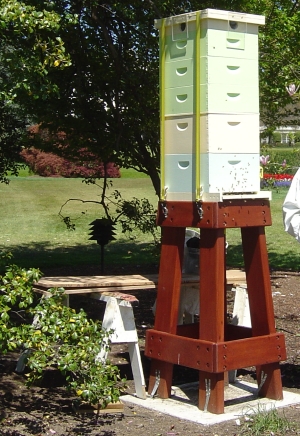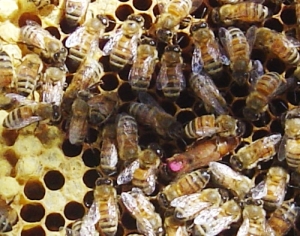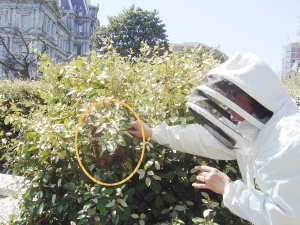 If there is one eternal truth in beekeeping, it's that committed beekeepers always get a bit nervous when someone else inspects their hive, especially if that someone else has kept bees even one week longer. I've got a few years on Charlie, bee-wise, but not that many. Even so, it makes my heart get all warm to see such concerns, because only people who really care have them. And the bees do so much better in the hands of those who care. Which is my way of saying that Charlie let me have a look at the White House honeybees today. Thanks, Charlie!
If there is one eternal truth in beekeeping, it's that committed beekeepers always get a bit nervous when someone else inspects their hive, especially if that someone else has kept bees even one week longer. I've got a few years on Charlie, bee-wise, but not that many. Even so, it makes my heart get all warm to see such concerns, because only people who really care have them. And the bees do so much better in the hands of those who care. Which is my way of saying that Charlie let me have a look at the White House honeybees today. Thanks, Charlie!
Before I go on, this needs to be said: everything touching on that particular place tends to get wrapped up in spotlights and drama, and there is a real danger of feeling self-important or personally special just because of that place and this time. When I share this with you, please keep in mind what this is really about: the bees, and their way of both supporting our environment and inspiring great wonder in those who look after them. I feel that we all owe Charlie a whole lot, and I want him and the Obamas (remember, it's their back yard right now!) and Sam Kass (whose garden project makes it all possible) to get their credit, too.
But I bet you want a look in, too.
 With apologies for the rough crop of the photo, this is how you work the White House bees: on a board set on two sawhorses. It helps to coordinate your movements and to balance anything you are up to with the other person up there! It is a surprisingly stable solution, with the plus that the bees that fall during a manipulation don't end up getting stomped, and you don't have to tuck in your socks to keep them from crawling up a pants leg! The groovy piece of woodenware (the one shielded by some plexiglass near the holes) is a vent of Charlie's own design. The plexi helps moderate high winds, whether natural or from helicopters. One unforeseen benefit of the hive scaffold: it is really easy to look up through the screened bottom board to see where/how tight the bees are clustering.
With apologies for the rough crop of the photo, this is how you work the White House bees: on a board set on two sawhorses. It helps to coordinate your movements and to balance anything you are up to with the other person up there! It is a surprisingly stable solution, with the plus that the bees that fall during a manipulation don't end up getting stomped, and you don't have to tuck in your socks to keep them from crawling up a pants leg! The groovy piece of woodenware (the one shielded by some plexiglass near the holes) is a vent of Charlie's own design. The plexi helps moderate high winds, whether natural or from helicopters. One unforeseen benefit of the hive scaffold: it is really easy to look up through the screened bottom board to see where/how tight the bees are clustering.
As you might imagine, a couple of key concerns for bees in this location are swarm control, and monitoring temperament. Our visit today was mostly around the former: to keep tabs on how they are building up and reverse the hive bodies if that seemed useful, and to make sure there were enough supers in place for the current and soon-to-be-upcoming nectar flow.
 To my mind, Charlie's queen is a good one for the job. The bees were extremely peaceful and gentle, and her pattern was OK, though not gangbusters. In a situation like this, I am all for the happy medium in terms of brood production! The drone brood was in the right place, she seemed to lay more from right to left than in a spiral starting in the center of the frame. You can click that picture of her for a slightly larger version.
To my mind, Charlie's queen is a good one for the job. The bees were extremely peaceful and gentle, and her pattern was OK, though not gangbusters. In a situation like this, I am all for the happy medium in terms of brood production! The drone brood was in the right place, she seemed to lay more from right to left than in a spiral starting in the center of the frame. You can click that picture of her for a slightly larger version.
When we opened some drone brood, there was a minimal presence of varroa. There were no k-wings and I saw no mites on bees. The hive has three medium supers with drawn comb, there is a fair amount of nectar in the first two, so Charlie is out ahead of this one. They had put aside some honey down below, but I am seeing that at home, too. Nice white cappings.
 Finally, as I was saying goodbye, Charlie got a call aboutanother swarm at the north gate! I said I would take it if accessible. So we checked it out. It was clearly a second swarm, probably thrown off of the same nearby hive that produced the famous one last week: about 2 pounds (1 kg) of bees (image is clickable for a better view). Since I am giving away a split this weekend, I thought my friend might want this queen to go with it!
Finally, as I was saying goodbye, Charlie got a call aboutanother swarm at the north gate! I said I would take it if accessible. So we checked it out. It was clearly a second swarm, probably thrown off of the same nearby hive that produced the famous one last week: about 2 pounds (1 kg) of bees (image is clickable for a better view). Since I am giving away a split this weekend, I thought my friend might want this queen to go with it!
Charlie got me a box, poked some holes in it with a nail, and we borrowed some bolt cutters from the carpentry shop to lop a small limb off the swarm bush. Sorry bush! He sealed the box shut with blue gaffer's tape, and in a supporting page (a bit later) I will tell you about my hapless adventures in hiving it when I got home.
So once again, thank you for including me in this adventure, for doing such a wonderful thing, and for taking care of those girls the way any one of us would hope our own home hives get tended. I hope you get as much help as you could possibly need in helping them thrive so close to the heart of our nation!
14 comments:
What a great opportunity! I'm glad I found your blog just as you posted this. One observation though...are those four vents that are shielded by plexiglass? Those are rather large. Can you give some more detail about that?
The woodenware with the vent holes is just taller than a shim, and inside there is a baffle that further moderates the flow of air (a piece of wood with cutouts at the corners) -- there is no fan or mechanicals, just the chimney effect. I have a picture that I will try to post later. The plexi is to keep outside wind from blowing in, but it further slows the outbound air flow, too.
Hey, I just found your blog...I too am an urban beekeeper. I have been for a few years and never had any troubles. Most folks appreciate knowing I have bees and no one seems to mind after I show them around some. Anyhow, thanks for posting!
Hello City Bee - Thanks for your great blog. I am a new beekeeper in a city where beekeeping is illegal, and I'm wondering whether beekeeping is legal in DC. In our effort to legalize beekeeping here, it would be helpful information. Thanks.
Couldnt help but wonder how tricky it might be to manipuate that hive(full honey supers). Whats the idea behind the extra high hive stand?
I'm wondering about the stand also. Seems like a GREAT way to manage flight path in a busy garden, and I'd do it in mine in a heartbeat. Except. . . how would you manage it on a platform without a partner? Those supers are heavy?
I am so glad to have found your blog. I am a long lost beekeeper from my days as a Peace Corps Vol in Africa - and have wanted to start a hive here in Takoma DC - but did not know it was legal. What is the best way to obtain information about the legal constraints on beekeeping in DC?
I am so glad to have found you City Bees... I am a long lost beekeeper from my days as a Peace Corps volunteer in Africa... and have wanted to start keeping bees but did not know it was legal in DC... what is the best way to obtain information about the requirements for keeping a hive on residential property here in DC? I live in a single family detached with a nice big yard in Takoma DC...
Hey Peter --
Two things:
First of all, the way the season works around here (one major nectar flow from late April to mid-June, max) you would have to have your hive started already to have much chance of having them survive. In fact, it would be hard for you to find bees to start with right now.
Second, the state of legality in DC is pretty much in the eye of the beholder, though I am trying to change that. Beehives are not illegal in DC, and they are legal on Federal property with the permission of the governing agency, though there are restrictions and permissions that are in conflict with each other. Many urban areas have either recently or are in the process of loosening or removing restrictions on beekeeping, and this is very much a movement I am trying to bring here. I know beekeepers in your neighborhood, though, and would be willing to make an introduction.
Thanks very much - I would love to get in touch with some of my local beekeepers in the neighborhood... and look forward to getting things set up for next year's nectar flow...
This is great to see! Thanks for posting this all for us to see.
What a great adventure!
Nick
I have 58 acres in Charlottesville Virginia on which I have started a small apple orchard and want to establish a bee hive. Thirty five years ago in Los Angeles I had a hive in my back yard and greatly enjoyed bee keeping. Now I have to start all over with hives, supers, foundations and bees. There do not seem to be any apiary societies on the web in the Washington DC area. I actually live in Bethesda Maryland. Any advice you might have for me as to sources for equiptment and live bees I would greatly appreciate.
Loved your blog.
Ann
The nearest beekeeping club to Bethesda, Maryland is the Montgomery County Beekeepers, www.montgomerycountybeekeepers.com, though also to the west of Washington DC you can hook up with the Beekeepers of Northern Virginia, www.beekeepersnova.org.
Beekeeping in the MidAtlantic would be pretty different from LA -- for one thing, the winter preparations might be pretty unfamiliar. Most beekeepers here start out by taking a low cost --you pay for course materials only -- short course which usually occurs over 4-6 weeks in the very early Spring, though the Prince George's County beekeepers hope to offer a quick intro course sometime this Fall -- keep an eye on www.bumbabees.com for info.
When you take the course or attend meetings, you get access to all sorts of recommendations for equipment that are suited to your particular situation, as well as places to buy bees. It really helps to get to know your local beekeepers to learn what works around where you are, and to get access to all this stuff in a timely and reliable fashion. I'd rather not recommend specific vendors on this blog.
It would be a real pleasure to welcome you to the local beekeeping community!
Post a Comment